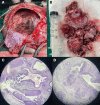Large Immature Intracranial Teratoma in an Infant: A Case Report
- PMID: 38196986
- PMCID: PMC10774073
- DOI: 10.7759/cureus.51891
Large Immature Intracranial Teratoma in an Infant: A Case Report
Abstract
Intracranial immature teratomas are rare, highly malignant, and fast-growing with a poor prognosis. We report the case of an infant with a large immature teratoma in the intracranial compartment. A two-month-old child presented to the emergency room with drowsiness and seizures. CT and cranial MRI showed hydrocephalus with a large expansive process in the right cerebral hemisphere extending to the infratentorial compartment, compressing the cerebellum and brainstem. It was then decided to partially resect the lesion. Postoperatively, due to the aggressiveness of the residual tumor, the patient developed complications (status epilepticus, hyperthermia, and electrolyte disorders) and died. Histopathological and immunohistochemical studies confirmed an immature teratoma. Teratomas are a subtype of germ cell tumors. Immature teratomas contain a population of cells that retain embryonic characteristics and tissues with more primitive components derived from all or some of the three germ layers (ectoderm, mesoderm, and endoderm). The prognosis of immature teratomas is associated with the degree of tumor differentiation, and those composed of undifferentiated embryonic tissues have a poor prognosis. This case report illustrates the rare and severe occurrence of a bulky immature cerebral teratoma in an infant. Unfortunately, despite undergoing a planned partial resection, the infant ended up having complications and died. Therefore, due to the size of the lesion in an infant, these cases are always complex when deciding on a surgical approach.
Keywords: acute hydrocephalus; immature teratoma; nervous central system; somatic malignancy; tumours.
Copyright © 2024, Da Silva et al.
Conflict of interest statement
The authors have declared that no competing interests exist.
Figures


Similar articles
-
Intracranial immature teratoma with a primitive neuroectodermal malignant transformation - case report and review of the literature.Rom J Morphol Embryol. 2016;57(4):1389-1395. Rom J Morphol Embryol. 2016. PMID: 28174809 Review.
-
Intracranial germ cell tumors: pathobiological and immunohistochemical aspects of 70 cases.J Neuropathol Exp Neurol. 1985 Jan;44(1):32-46. J Neuropathol Exp Neurol. 1985. PMID: 4038412
-
Maturation of intracranial immature teratomas. Report of two cases.J Neurosurg. 1996 Oct;85(4):672-6. doi: 10.3171/jns.1996.85.4.0672. J Neurosurg. 1996. PMID: 8814173
-
Immature teratomas of childhood. Report of 21 cases.Pathol Res Pract. 1985 Jan;179(3):388-400. doi: 10.1016/S0344-0338(85)80148-5. Pathol Res Pract. 1985. PMID: 3983017
-
Primary immature teratoma of the thigh: a review.Eur J Orthop Surg Traumatol. 2023 May;33(4):773-778. doi: 10.1007/s00590-022-03256-5. Epub 2022 Mar 31. Eur J Orthop Surg Traumatol. 2023. PMID: 35377080 Review.
Cited by
-
Mature Teratoma of the Cerebellum with Formed Extracranial Component.J Clin Med. 2025 Mar 15;14(6):1994. doi: 10.3390/jcm14061994. J Clin Med. 2025. PMID: 40142802 Free PMC article.
References
-
- Congenital immature teratoma of the fetal brain. Rickert CH, Probst-Cousin S, Louwen F, Feldt B, Gullotta F. Childs Nerv Syst. 1997;13:556–559. - PubMed
-
- Perinatal (congenital and neonatal) neoplasms: a report of 110 cases. Isaacs H Jr. Pediatr Pathol. 1985;3:165–216. - PubMed
-
- Massive congenital intracranial immature teratoma of the lateral ventricle with retro-orbital extension: a case report and review of the literature. Arslan E, Usul H, Baykal S, Acar E, Eyüboğlu EE, Reis A. Pediatr Neurosurg. 2007;43:338–342. - PubMed
-
- Pure immature teratoma of the ovary in adults: thirty-year experience of a single tertiary care center. Alwazzan AB, Popowich S, Dean E, Robinson C, Lotocki R, Altman AD. https://ijgc.bmj.com/content/25/9/1616.long. Int J Gynecol Cancer. 2015;25:1616–1622. - PMC - PubMed
Publication types
LinkOut - more resources
Full Text Sources
